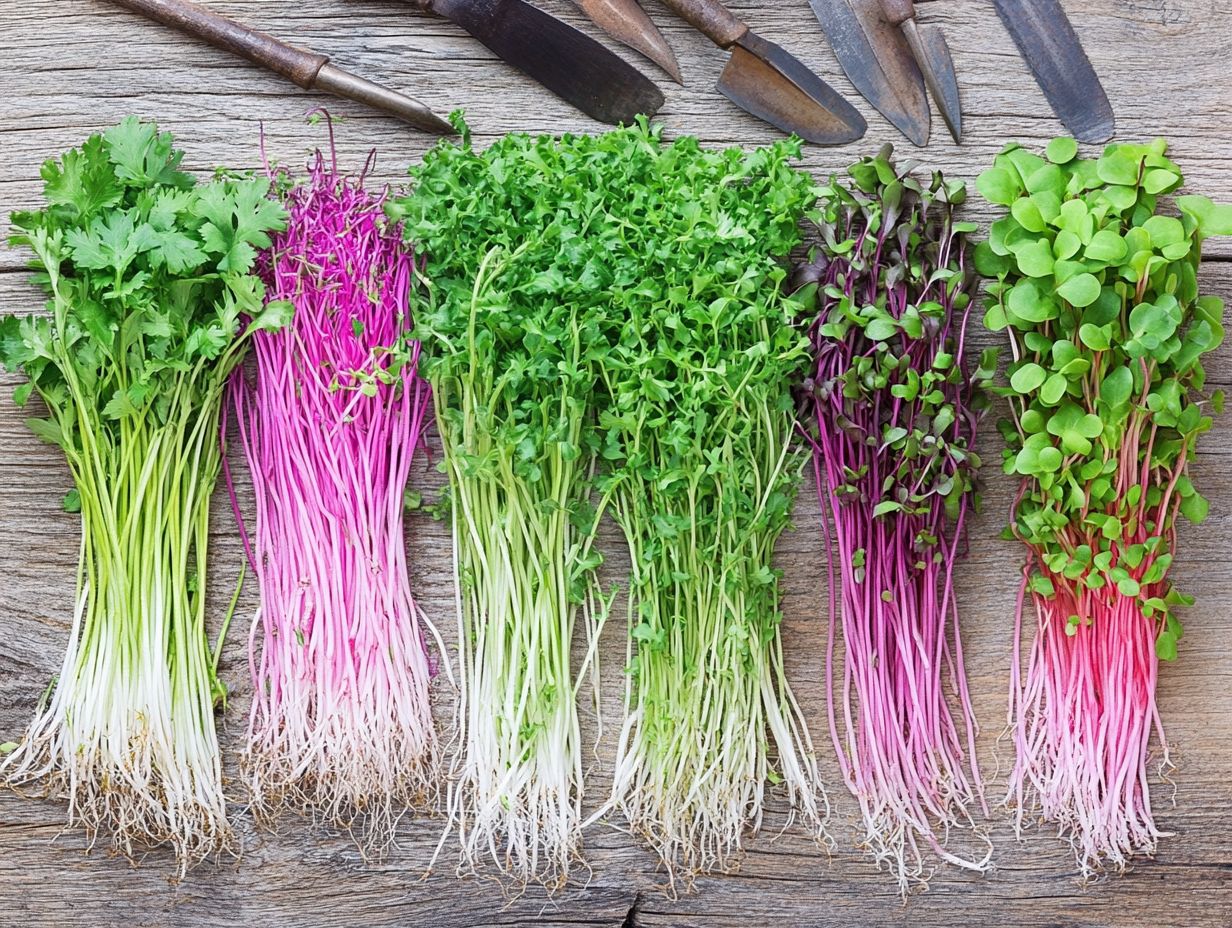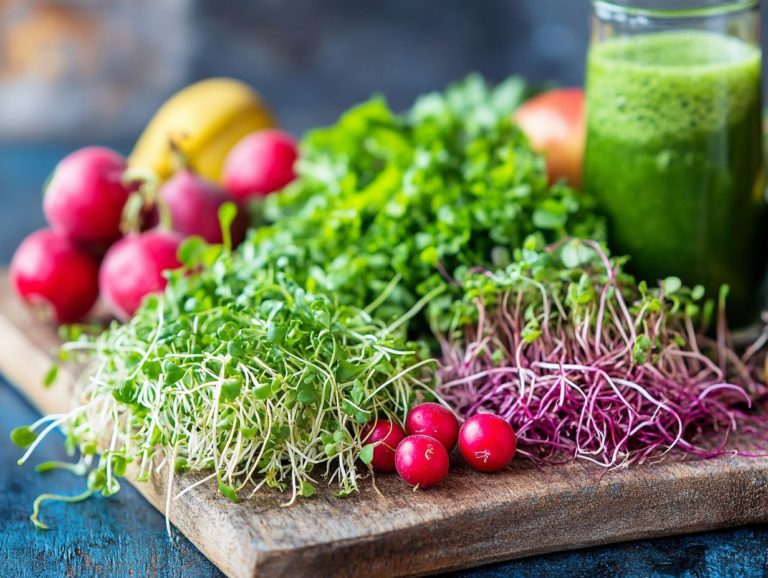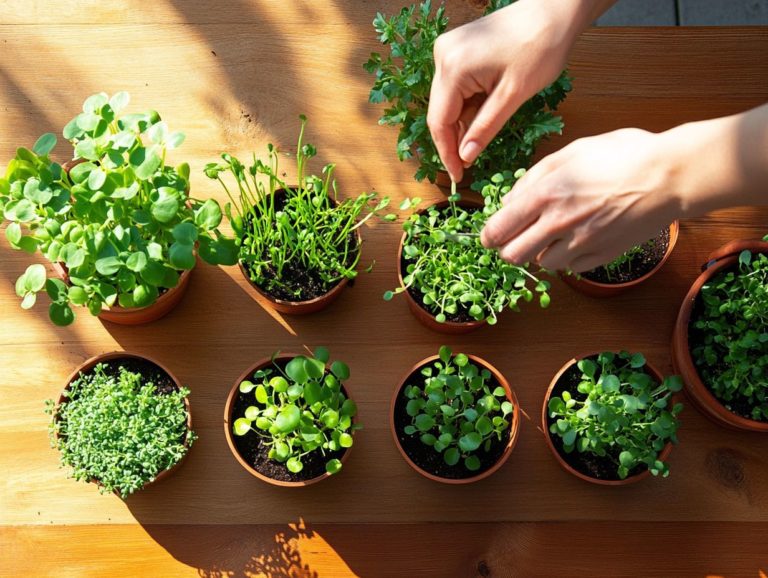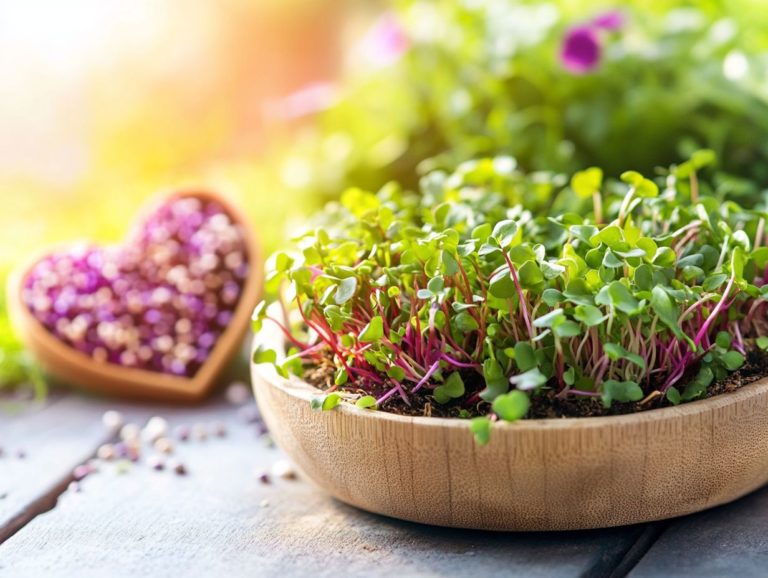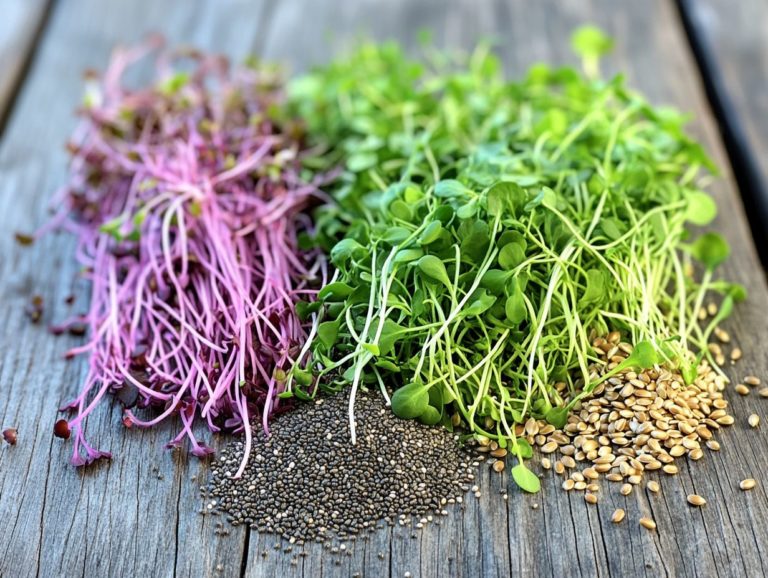5 Microgreens for Enhanced Bone Density
Microgreens are not just tiny plants; they are little powerhouses of nutrition that can help improve your bone density.
In this exploration of the microgreens universe, you ll discover standout varieties such as broccoli, red cabbage, sunflower, radish, and pea shoots, each celebrated for their remarkable bone-strengthening properties.
But that s just the beginning. You ll also learn how to seamlessly incorporate these vibrant greens into your diet, uncover additional health benefits, and enjoy some delectable recipes along the way.
Whether you re a dedicated health enthusiast or simply curious about these nutrient-packed morsels, you re about to embark on an enlightening journey that will enhance both your knowledge and your meals.
Contents
- Key Takeaways:
- 1. What Are Microgreens?
- 2. How Do Microgreens Help with Bone Density?
- 3. Broccoli Microgreens
- 4. Red Cabbage Microgreens
- 5. Sunflower Microgreens
- 6. Radish Microgreens
- 7. Pea Shoot Microgreens
- 8. How to Incorporate Microgreens into Your Diet
- 9. Other Benefits of Microgreens
- 10. Potential Risks and Precautions
- Are Microgreens a Substitute for Traditional Treatment Methods?
- Frequently Asked Questions
- Which microgreens boost bone density?
- How do microgreens help improve bone density?
- Can microgreens be consumed by people of all ages for enhanced bone density?
- How should I incorporate these microgreens into my diet for enhanced bone density?
- Are there any side effects of consuming microgreens for enhanced bone density?
- Is there any scientific evidence to support the effectiveness of microgreens for enhanced bone density?
Key Takeaways:

- Incorporating 5 microgreens into your diet can help enhance bone density and prevent bone-related issues.
- Broccoli, red cabbage, sunflower, radish, and pea shoot microgreens are specifically beneficial for bone health.
- Growing microgreens at home is a fun and rewarding experience! They can be consumed in various ways, making them a convenient and nutritious addition to any diet.
1. What Are Microgreens?
Microgreens are young, edible plants harvested at an early growth stage. They are celebrated for their vibrant colors, intense flavors, and impressive nutrient density.
If you’re health-conscious and looking to elevate your diet, these tiny greens are a fantastic choice. They re brimming with vitamins, minerals, and antioxidants that can enhance your overall health.
Varieties like arugula, broccoli, kale, and radish not only offer diverse flavors but also elevate your culinary creations while boosting your nutrient intake.
Cultivating microgreens is surprisingly simple, requiring minimal space and resources, making them an excellent option for urban gardening enthusiasts.
Research from Eurofins Scientific and BioTeSys shows that microgreens have elevated levels of vitamins such as A, C, E, and K, along with essential minerals. The health benefits are impressive these greens can support your immune system, enhance brain health, and keep your energy levels soaring throughout the day.
By incorporating microgreens into your meals, you can effortlessly add a vibrant punch of nutrition to your diet.
2. How Do Microgreens Help with Bone Density?
Microgreens, particularly those abundant in calcium, are essential for boosting bone density and overall skeletal health. Adding them to your balanced diet is a proactive step in preventing osteoporosis and other bone-related issues.
Among the standout varieties are kale, bok choy, and arugula, all renowned for their impressive calcium content. For those looking to enhance their diet, consider adding 7 microgreens packed with vitamins. Research underscores the importance of adequate calcium intake for maintaining strong and resilient bones, showing that those who regularly consume calcium-rich foods often enjoy denser bones.
Calcium is just one benefit; microgreens are also packed with vitamins and antioxidants, which further support bone health by helping protect your bones from damage. Recent nutritional analyses indicate that incorporating these tiny greens, such as the top 5 microgreens for smoothies, into your meals can elevate your overall nutrient intake and potentially decrease the risk of fractures as you age.
3. Broccoli Microgreens
Broccoli microgreens are truly a powerhouse, renowned for their remarkable health benefits. With high levels of sulforaphane and antioxidants, they work wonders in combating cancer and supporting cellular health.
But that’s not all; these tiny greens also pack essential nutrients like vitamin C and iron. Vitamin C is your ally in boosting the immune system, helping your body ward off infections and illness. Meanwhile, iron plays a crucial role in transporting oxygen throughout your body, essential for maintaining your energy levels and overall vitality.
The combination of these nutrients not only enhances your immunity but may also contribute to cancer prevention by neutralizing free radicals and reducing inflammation. Incorporating broccoli microgreens into your health-conscious diet is a smart and beneficial choice.
Ready to supercharge your meals? Start growing and enjoying microgreens today!
4. Red Cabbage Microgreens
Red cabbage microgreens are a feast for the eyes and a powerhouse of antioxidants. They are packed with essential vitamins that elevate your overall health.
Loaded with vitamin C and K, these petite greens help reduce inflammation and support your immune function and bone health. Their vibrant hue comes from natural pigments that combat oxidative stress.
Compared to other microgreens like broccoli or radish, red cabbage microgreens have a higher nutrient value. Adding these gems to your meals not only gives a delightful crunch but also boosts your nutrient profile, promoting overall well-being.
5. Sunflower Microgreens
Sunflower microgreens are known for their delightful crunch and nutty flavor. They are a robust source of energy and protein, perfect for enhancing your diet.
These tiny greens are rich in essential nutrients and have impressive protein content, crucial for muscle repair and growth. They provide a natural energy boost, ideal for active lifestyles.
Incorporate them into salads, sandwiches, smoothies, or grain bowls. They not only elevate flavors but also significantly boost your nutrition!
6. Radish Microgreens
Radish microgreens add a zesty flavor to any dish. They are loaded with antioxidants that support heart health and invigorate the immune system.
These greens bring a peppery kick, perfect for salads and sandwiches. They also help lower cholesterol levels, an essential step for a healthy heart.
Sprinkle them on tacos, blend them into smoothies, or use them as a garnish for soups and omelets. Their versatility is perfect for enhancing your meals while benefiting your heart.
7. Pea Shoot Microgreens
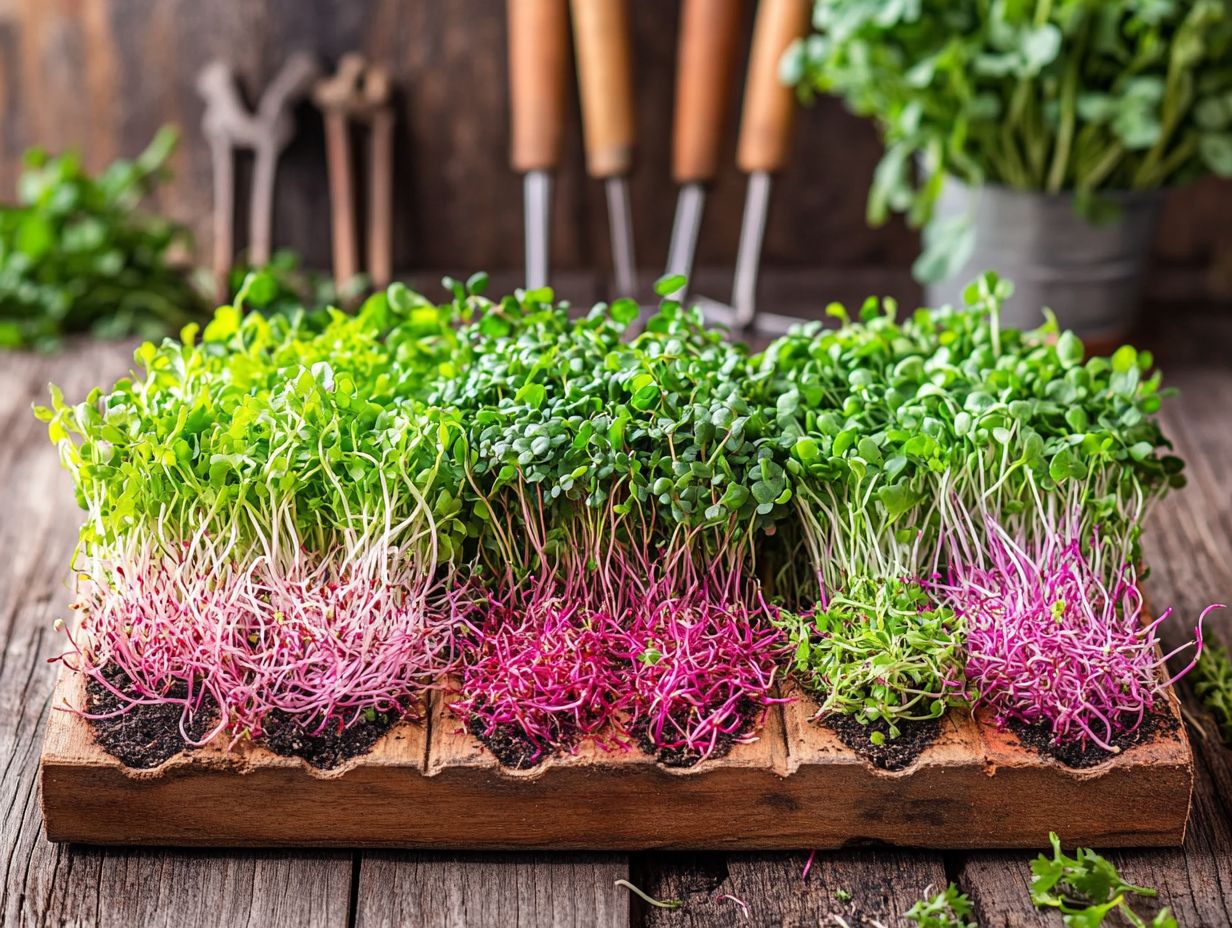
Pea shoot microgreens are cherished for their delicate sweetness and tender texture. They are an excellent source of vitamins and protein essential for muscle health.
Packed with vitamins A, C, and K, they support immune health, skin vitality, and blood clotting. Their protein content is particularly beneficial for muscle repair and energy levels.
Add pea shoots to salads for crunch, blend them into smoothies for a nutrient boost, or saut them as a flavorful side dish. Their versatility means you can enjoy their health benefits easily!
8. How to Incorporate Microgreens into Your Diet
Incorporating microgreens into your diet is an effortless yet impactful way to elevate your fresh greens intake and infuse your meals with nutrient-packed goodness. This enhances both flavor and health benefits.
These tiny, vibrant greens are bursting with taste and nutrition, making them a versatile addition to various dishes. For instance, tossing a handful of radish microgreens into a crisp salad introduces a zesty kick. Adding pea shoots to a sandwich not only enhances the flavor but enriches the overall nutrient profile. If smoothies are more to your liking, blend in some sunflower microgreens; they bring a subtly nutty flavor along with a treasure trove of vitamins. To discover 5 microgreens to boost your metabolism, consider incorporating these greens into your meals.
Experimenting with various microgreens can transform your everyday recipes into extraordinary culinary experiences.
9. Other Benefits of Microgreens
Beyond their impressive nutritional profile, microgreens offer a wealth of health benefits that elevate them to the status of superfoods. They enrich your diet with essential antioxidants and support bodily functions.
These tiny powerhouses are brimming with vitamins and minerals that play a crucial role in strengthening your immune system, vital for warding off infections. Varieties like basil and kale enhance brain health by supporting cognitive function and reducing mental fatigue.
Microgreens also contribute to cellular health, aiding in tissue repair and regeneration through their diverse array of natural compounds found in plants that can promote health. By incorporating these vibrant greens into your meals, you add delightful flavor and texture while promoting overall wellness. For instance, consider 5 microgreens for enhancing eye health, making them an invaluable addition to your balanced diet.
10. Potential Risks and Precautions
While microgreens are generally a safe and healthy addition to your diet, be aware of potential risks to stay safe while enjoying them.
Contamination can happen during the growing process, especially if hygiene practices are overlooked. If growers fail to sterilize their tools or use contaminated water, harmful pathogens can thrive among these delicate plants.
To reduce these risks, always start with certified seeds specifically intended for microgreen cultivation. Ensure that all your growing equipment is thoroughly cleaned beforehand. Proper handling during harvesting and storage is also key. Keeping microgreens in a cool, dry place in a breathable container can significantly lower the chances of spoilage and bacterial growth. Don t miss out on savoring the vibrant flavors and nutritional benefits these little greens have to offer.
Are Microgreens a Substitute for Traditional Treatment Methods?
Microgreens, while undeniably beneficial, should not be regarded as a substitute for traditional treatment methods for serious health conditions like cancer and diabetes. Instead, think of them as a complementary addition to a balanced diet.
These petite greens are brimming with vitamins, minerals, and antioxidants that elevate your overall well-being and potentially reduce the risks linked to chronic diseases. They offer essential nutrients that bolster immune function and may contribute to improved heart health. Additionally, incorporating the best microgreens for bone health can further enhance your nutritional intake.
It’s crucial to seek personalized guidance from healthcare professionals before making any significant dietary shifts. Medical advice tailored to your unique needs is vital, especially when navigating complex health issues.
How Can One Grow Microgreens at Home?
Growing microgreens at home is not just a sustainable practice; it’s a rewarding experience that allows you to enjoy fresh greens while enhancing your culinary creations and boosting your nutritional intake.
This endeavor opens the door for you to embrace a healthier lifestyle while connecting with nature, even in a small space. By setting up an ideal indoor garden complete with grow lights and proper drainage you can start your journey today to cultivate these vibrant plants.
Choosing the right seeds is essential; options like radish, sunflower, and kale cater to various flavor profiles and nutritional needs. With consistent watering and adequate light, these tiny powerhouses of nutrition will thrive, bringing an abundance of flavors and health benefits right into your kitchen. For an even greater nutritional boost, explore the top 10 microgreens to add to your next meal for a delicious enhancement!
What Are the Best Ways to Consume Microgreens?
Discover the myriad of delicious ways you can enjoy microgreens, seamlessly integrating these healthy superfoods into your daily meals while savoring their exceptional health benefits.
Imagine vibrant salads bursting with flavor or energizing smoothies that set a positive tone for your day. Microgreens have the remarkable ability to transform everyday dishes into exquisite culinary experiences. Just a handful of these tiny greens not only enhances the visual appeal but also packs a powerful punch of nutrients.
For example, mix arugula microgreens into a refreshing cucumber and tomato salad to elevate its flavor profile. Blending beet microgreens into your smoothie introduces an earthy sweetness and a stunning pop of color. You might also consider using microgreens as a garnish for soups or entrees, allowing their unique flavors to shine while delivering a nutrient boost with every delightful bite! To explore more options, check out 5 microgreens to boost energy levels.
What Nutritional Benefits Do Microgreens Offer?

Microgreens are truly celebrated for their remarkable nutritional benefits, often offering higher concentrations of vitamins and minerals than their fully grown counterparts. This makes them a valuable addition to your diet!
These small, tender greens are brimming with essential nutrients that can significantly enhance your overall health. Research conducted by Eurofins Scientific and BioTeSys highlights that various microgreens, such as radish, broccoli, and sunflower, are rich in vitamins A, C, E, and K, along with beneficial phytochemicals—natural compounds in plants that can offer health benefits. For example, you can discover more about 5 nutritious microgreen varieties for smoothies, where broccoli microgreens contain sulforaphane, which has been linked to cancer prevention, while the high vitamin C content in pea shoots supports immune function and skin health.
By incorporating these vibrant greens into your daily meals, you can effortlessly elevate your nutrient intake and promote robust well-being.
Can Microgreens Help with Other Health Conditions?
Microgreens are your secret weapon in the quest for better health! Packed with high levels of antioxidants and essential nutrients, these tiny greens can support your immune system and help manage a range of health conditions.
But that’s not all; they’re also brimming with vitamins and minerals, along with a concentration of phytochemicals that play a crucial role in promoting heart health. Research suggests that varieties like broccoli and radish microgreens, including top microgreen varieties for breakfast, contain compounds that may help lower cholesterol levels and enhance arterial function.
Their low glycemic index makes microgreens a smart choice for anyone managing diabetes, as studies have shown they can assist in regulating blood sugar levels. In terms of cancer prevention, microgreens like arugula are particularly noteworthy; they contain sulforaphane, a compound linked to a reduced risk of certain cancers.
Clearly, these nutrient-dense plants are a powerful ally in your journey toward optimal health!
What Are Some Delicious Recipes Using Microgreens?
Exploring delightful recipes featuring microgreens can inspire you to elevate your meals with fresh greens while enjoying the myriad dietary benefits these superfoods bring.
With their vibrant hues and distinct flavors, microgreens can transform everything from salads and sandwiches to soups and smoothies. For instance, mustard greens add a zesty kick that can enliven a simple vinaigrette, while pea shoots introduce a gentle sweetness to any dish. Incorporating 5 microgreens that support healthy aging can also enhance your meals while promoting well-being.
Encouraging your creativity in the kitchen, sprinkle radish microgreens on tacos or fold them into omelets for an extra nutritional boost. Using sunflower microgreens as a garnish not only enhances visual appeal but also adds a delightful crunch!
Embracing these tiny greens opens up a world of possibilities for health-conscious culinary adventurers like you. Experiment with these tips and share your favorite microgreen recipes!
Frequently Asked Questions
Which microgreens boost bone density?
The top 5 microgreens for enhanced bone density are broccoli, kale, spinach, mustard greens, and red clover.
How do microgreens help improve bone density?
Microgreens are rich in various vitamins and minerals, including calcium, magnesium, and vitamin K, which are essential for maintaining strong bones and improving bone density.
Can microgreens be consumed by people of all ages for enhanced bone density?
Absolutely! Microgreens are delicious and safe for everyone, making them a fantastic addition to your diet.
How should I incorporate these microgreens into my diet for enhanced bone density?
Add microgreens to salads, sandwiches, and smoothies, or use them as toppings. You can also find creative recipes that include microgreens.
Are there any side effects of consuming microgreens for enhanced bone density?
No known side effects exist for eating microgreens. Always consult a healthcare professional before making major dietary changes, though.
Is there any scientific evidence to support the effectiveness of microgreens for enhanced bone density?
Yes, studies show that vitamins and minerals like calcium, magnesium, and vitamin K in microgreens can boost bone density. Many experts suggest including microgreens in your healthy diet to support strong bones.
